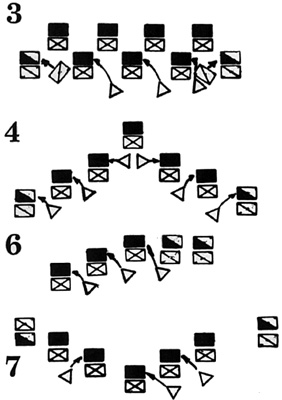
The article Phalanx Formations by David Glick in Volume III, No. 4 of THE COURIER has a great deal of promise. Heretofore, ancient generals have either concentrated on terrain advantages or troop advantages to win battles. Simply put, weak troops are strengthened by terrain and strong troops seek out the foe. To my mind, the formations adopted by an army should have decisive effect.
My weak troops, properly deployed and employed, should be capable of defeating my opponent's strong troops. Phalanx Formations is the first printed tactical article that I have seen that recognizes that tactical deployment has as much importance, and perhaps more, than super troops or palisaded villages.
An active opponent, however, would notice Mr. Glick's formations well in advance of impact and would arrange his troops to deal with each of Mr. Glick's strategems. Therefore, the advance on the enemy should take place in any one of the basic modifications of the reinforced line. The change to any of the tactical formations suggested by Mr. Glick should not be initiated until the last possible moment before impact.
This requires either a staggered advance in the turn or two prior to impact or careful selection of hold and attack orders. In addition, the advance should be conducted in a manner that unit frontages do not overlap enemy units. There is nothing more frustrating than to have your unit strike an enemy unit and have a small overlap onto another hostile unit. If this happens, rarely does the breach in the enemy line take place. Both timing and space are of the utmost importance.
By way of explanation, a competent general will assume the checkered formation either by stagering his advance on the last turn before impact or by giving even numbered units attack orders. Similarly the wedge can be developed by advancing quickly in the center. It can also be developed by giving the center attack orders and the wings hold orders. The refused flank is developed either by a slow advance in the last turn by the weak flank with a quick advance by the strong flank ,or by giving the weak flank hold orders and the strong flank attack orders.
You may ask yourself what difference does it make when you hit the enemy line so long as you either hit his weak troops with your stronger or outnumber the foe at the point of impact?
The reason that you want a staggered or delayed impact with clean impact on a unit by unit basis is to open holes in the enemy's line. Most foot fight in more than one rank and there are various melee disadvantages to disorder. The two are connected. It's a basic tactical rule to use a reinforced line. It's also a basic rule that he who commits the last cavalry unit wins despite the unfair treatment given horse by the WRG Sixth Edition.
Take a look at any of Mr Glick's diagrams. Place hostile units in melee on a one to one basis with each of the friendly units. In figures 3, 4, 6, and 7, the hostile units that have penetrated the most distance towards the bottom of the page will have exposed flanks to the friendly second line. See the diagrams below. Hostile units are shaded and space is approximated and not to scale. All reserve troops should be completely screened by the front line on impact.
It is extremely important that the units in reserve in the second line (primarily cavalry units in wedge or light cavalry units) should be completely screened by the friendly units in the front line. Otherwise, hostile reserve units may foil the attack by declaring charges on the friendly reserves through the same gaps that the friendlies are attempting to exploit. In each of the diagrams, the hostile units have exposed a flank to attack. I use cavalry as a reserve because I feel that its speed and manueverability allow it to take the most advantage of the exposed flanks.
However, it has been suggested that light infantry, light medium infantry, and light heavy infantry are equally suitable as a reserve. Mr. Glick neglected to mention that small cavalry wedges operating to the rear of the main lines will be able to charge into those exposed flanks if positioned correctly. In addition, I have little to lose, The cavalry, having no one fighting back, will not recoil. The foot if they are pushed back will rally. Line 18 on page 44 of the WRG Sixth Edition require that all of the foe recoil or break before a follow up is permitted. As the cavalry will not break in the first impact, the foot will not be followed up. C class or better foot will rally and be available to bail out the horse on the following turn if necessary.
The key to victory, in my mind, is timing. One can break up the integrity of a hostile line and rout half of the hostile units in one move if the timing is right. The alternative is to continue slogging along and hoping your good troops get to his weak troops before he gets to you, or worship the dice with great fervor.
Back to Table of Contents -- Courier Vol. IV #1
To Courier List of Issues
To MagWeb Master Magazine List
© Copyright 1982 by The Courier Publishing Company.
This article appears in MagWeb (Magazine Web) on the Internet World Wide Web.
Other military history articles and gaming articles are available at http://www.magweb.com